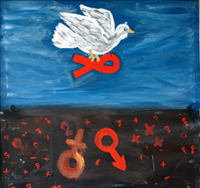
This painting was created by a Mozambican child through the “PositHIVe Art” program. This program allows HIV-positive children to express their feelings, with the help of a trained therapist, through drawings and paintings. The “PositHIVe Art” program takes place through the PEPFAR-supported Pediatric Day Hospital of Maputo. Photo by Mozambique PEPFAR team |
|
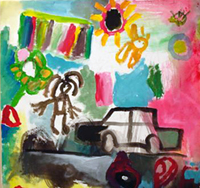
This painting was created by a Mozambican child through the “PositHIVe Art” program. This program allows HIV-positive children to express their feelings, with the help of a trained therapist, through drawings and paintings. The “PositHIVe Art” program takes place through the PEPFAR-supported Pediatric Day Hospital of Maputo. Photo by Mozambique PEPFAR team |
|
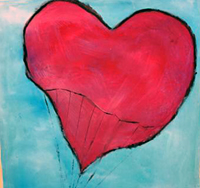
This painting was created by a Mozambican child through the “PositHIVe Art” program. This program allows HIV-positive children to express their feelings, with the help of a trained therapist, through drawings and paintings. The “PositHIVe Art” program takes place through the PEPFAR-supported Pediatric Day Hospital of Maputo. Photo by Mozambique PEPFAR team |
|
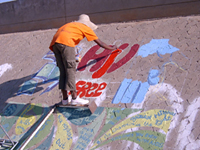
The PEPFAR-supported John Muafangejo HIV/AIDS Mural Painting Project was conducted in Windhoek, Namibia from August 20-25, 2007. The mural was painted at Dawid Bezuidenhout High School in Khomasdahl, a suburb of Windhoek. Photo by Namibia PEPFAR team |
| |
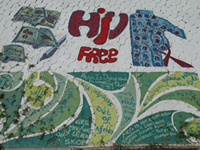
The PEPFAR-supported John Muafangejo HIV/AIDS Mural Painting Project was conducted in Windhoek, Namibia from August 20-25, 2007. The mural was painted at Dawid Bezuidenhout High School in Khomasdahl, a suburb of Windhoek. Photo by Namibia PEPFAR team |
|
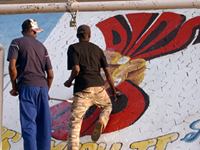
The PEPFAR-supported John Muafangejo HIV/AIDS Mural Painting Project was conducted in Windhoek, Namibia from August 20-25, 2007. The mural was painted at Dawid Bezuidenhout High School in Khomasdahl, a suburb of Windhoek. Photo by Namibia PEPFAR team |
|
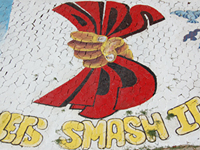
The PEPFAR-supported John Muafangejo HIV/AIDS Mural Painting Project was conducted in Windhoek, Namibia from August 20-25, 2007. The mural was painted at Dawid Bezuidenhout High School in Khomasdahl, a suburb of Windhoek. Photo by Namibia PEPFAR team |
|
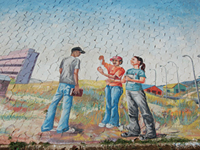
The PEPFAR-supported John Muafangejo HIV/AIDS Mural Painting Project was conducted in Windhoek, Namibia from August 20-25, 2007. The mural was painted at Dawid Bezuidenhout High School in Khomasdahl, a suburb of Windhoek. Photo by Namibia PEPFAR team |
| |
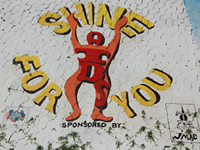
The PEPFAR-supported John Muafangejo HIV/AIDS Mural Painting Project was conducted in Windhoek, Namibia from August 20-25, 2007. The mural was painted at Dawid Bezuidenhout High School in Khomasdahl, a suburb of Windhoek. Photo by Namibia PEPFAR team |
|
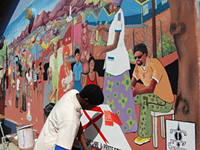
In August 2007, students from the Mandume Primary School in Katutura, the former Apartheid township of Windhoek, Namibia, collaborated with senior art students from the John Muafangejo Art Center in Katutura and local artists to create murals about HIV/AIDS at the school. The mission of this PEPFAR-supported mural painting project was to create AIDS awareness, to allow learners and artists to express feelings about HIV/AIDS, and to demonstrate the value of visual art in the depiction of cultural and historical heritage. Photo by Namibia PEPFAR team |
|
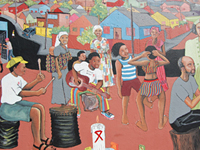
In August 2007, students from the Mandume Primary School in Katutura, the former Apartheid township of Windhoek, Namibia, collaborated with senior art students from the John Muafangejo Art Center in Katutura and local artists to create murals about HIV/AIDS at the school. The mission of this PEPFAR-supported mural painting project was to create AIDS awareness, to allow learners and artists to express feelings about HIV/AIDS, and to demonstrate the value of visual art in the depiction of cultural and historical heritage. Photo by Namibia PEPFAR team |
|
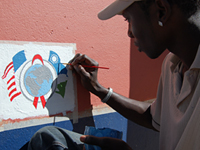
In August 2007, students from the Mandume Primary School in Katutura, the former Apartheid township of Windhoek, Namibia, collaborated with senior art students from the John Muafangejo Art Center in Katutura and local artists to create murals about HIV/AIDS at the school. The mission of this PEPFAR-supported mural painting project was to create AIDS awareness, to allow learners and artists to express feelings about HIV/AIDS, and to demonstrate the value of visual art in the depiction of cultural and historical heritage. Photo by Namibia PEPFAR team |
| |
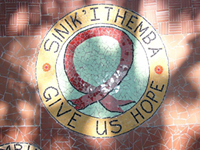
HIV/AIDS mosaic tiles appear in front of South Africa’s McCord Hospital Sinikithemba HIV and AIDS Clinic. Photo by South Africa PEPFAR team |
|
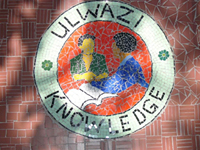
HIV/AIDS mosaic tiles appear in front of South Africa’s McCord Hospital Sinikithemba HIV and AIDS Clinic. Photo by South Africa PEPFAR team |
|
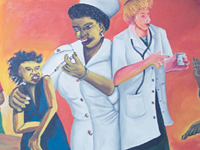
This mural was painted by patients at Hani Baragwananth Hospital in South Africa. Photo by South Africa PEPFAR team |
|
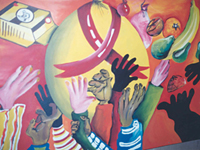
This mural was painted by patients at Hani Baragwananth Hospital in South Africa. Photo by South Africa PEPFAR team |
| |
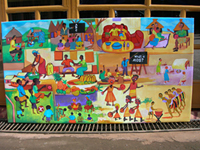
Let Art Talk hosted a cross section of children from different parts of Uganda to interact and exchange ideas in the form of artistic expression. These children learnt from each other how to cope with various challenges in life through different forms of artistic expression. This mural reflects the participating children’s conversation around the topic “What is AIDS?” Photo by Uganda PEPFAR team |
|
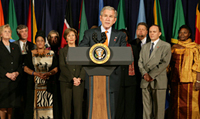
In recognition of World AIDS Day, President George W. Bush delivers a statement Friday, Nov. 30, 2007, after he and Mrs. Laura Bush participated in a roundtable in Mount Airy, Md., with faith-based groups regarding their roles in the global fight against HIV/AIDS. White House photo by Chris Greenberg |
|
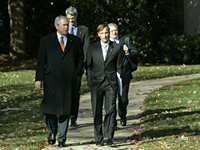
President George W. Bush departs the White House with Global AIDS Coordinator Mark Dybul, November 30, 2007, en route to Mount Airy, Maryland. White House photo by Eric Draper |
|
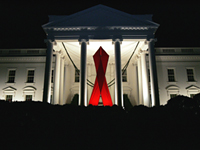
A red ribbon adorns the White House Friday, November 30, 2007, in recognition of World AIDS Day and the commitment by President George W. Bush and his administration to fighting and preventing HIV/AIDS in America and the world. White House photo by Chris Greenberg |
| |
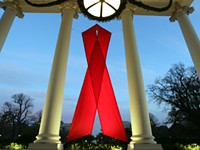
A red ribbon adorns the North Portico of the White House Friday, November 30, 2007, in recognition of World AIDS Day and the commitment by President George W. Bush and his administration to fighting and preventing HIV/AIDS in America and the world. White House photo by Eric Draper |
|
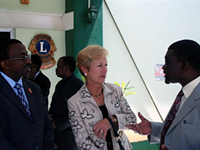
In Botswana, a workshop was held from November 6-7, 2007 for newspaper and broadcast journalists to enhance the quality of reporting of HIV/AIDS issues and to create opportunities for journalists to engage with HIV/AIDS stakeholders in Botswana. One objective of the workshop was to produce an 8-page newspaper supplement with stories written by the journalists from themes gathered at the 2-day workshop. More than 100,000 copies of the supplement was printed and distributed for readers in all major Botswana newspapers on World AIDS Day and over the following week. Ambassador Katherine Canavan speaks with National AIDS Coordinating Agency (NACA) Director Chris Molomo (right) and ACHAP Managing Director Dr. Themba Moeti outside of the journalist workshop. Photo by Botswana PEPFAR team |
|
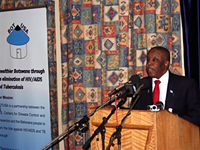
In Botswana, a workshop was held from November 6-7, 2007 for newspaper and broadcast journalists to enhance the quality of reporting of HIV/AIDS issues and to create opportunities for journalists to engage with HIV/AIDS stakeholders in Botswana. One objective of the workshop was to produce an 8-page newspaper supplement with stories written by the journalists from themes gathered at the 2-day workshop. More than 100,000 copies of the supplement was printed and distributed for readers in all major Botswana newspapers on World AIDS Day and over the following week. In a keynote address to journalists, President Mogae spoke of the need for Botswana to consider all prevention options in order to stage a comprehensive response against new infections. Photo by Botswana PEPFAR team |
|
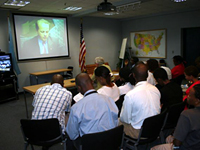
In Botswana, a workshop was held from November 6-7, 2007 for newspaper and broadcast journalists to enhance the quality of reporting of HIV/AIDS issues and to create opportunities for journalists to engage with HIV/AIDS stakeholders in Botswana. One objective of the workshop was to produce an 8-page newspaper supplement with stories written by the journalists from themes gathered at the 2-day workshop. More than 100,000 copies of the supplement was printed and distributed for readers in all major Botswana newspapers on World AIDS Day and over the following week. Journalists gather at the U.S. Embassy in Gaborone for an interactive video conference with Dr. Tom Kenyon, Principal Deputy Coordinator and Chief Medical Officer at OGAC, on the power of global partnerships. Also on the line was ACHAP Board Chairman Dr. Luke Nkinsi. Photo by Botswana PEPFAR team |
| |
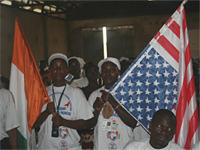
To mark World AIDS Day, the Cote d’Ivoire PEPFAR team took its ‘HIV/AIDS Road Show’ to Danane and Man, two major cities controlled by the New Forces (former Ivorian rebels) in Western Cote d’Ivoire. The aim of these outreach programs was to sensitize people, especially youth, living in the remotest parts of the country about how to prevent HIV/AIDS. Both sessions drew on a series of short films made by young Africans that address sensitive aspects related to HIV/AIDS by drawing on realistic situations presented in entertaining ways. Photo by Cote d’Ivoire PEPFAR team |
|
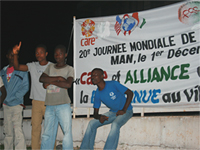
To mark World AIDS Day, the Cote d’Ivoire PEPFAR team took its ‘HIV/AIDS Road Show’ to Danane and Man, two major cities controlled by the New Forces (former Ivorian rebels) in Western Cote d’Ivoire. The aim of these outreach programs was to sensitize people, especially youth, living in the remotest parts of the country about how to prevent HIV/AIDS. Both sessions drew on a series of short films made by young Africans that address sensitive aspects related to HIV/AIDS by drawing on realistic situations presented in entertaining ways. Photo by Cote d’Ivoire PEPFAR team |
|
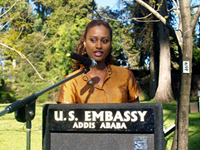
The US mission in Ethiopia, in collaboration with the PEPFAR Ethiopia coordination office, observed World AIDS day on Thursday, November 29, 2007 at the Embassy compound. During the event, Hayat Ahmed, a model and former Miss Ethiopia, said Ethiopians are known for their heroism and have a history of defending their nation’s sovereignty and territorial integrity. She said in the 21st century, Ethiopian patriotism should manifest in terms of their capacity to defeat HIV and AIDS. Photo by Ethiopia PEPFAR team |
|
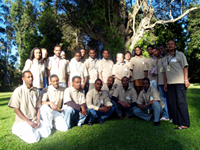
The US mission in Ethiopia, in collaboration with the PEPFAR Ethiopia coordination office, observed World AIDS day on Thursday, November 29, 2007 at the Embassy compound. T-shits, several take way items and a booklet including a World AIDS Day message from PEPFAR Washington were distributed to the entire mission staff during the event. Photo by Ethiopia PEPFAR team |
| |

In Namibia, D-Naff performs at the NamibiAlive II CD launch party at the Warehouse on November 21, 2007. The CD of songs and HIV/AIDS prevention messages will be distributed free of charge to bus, taxi, and combi drivers in an effort to reach Namibians by combining public transportation, HIV/AIDS prevention and the music scene. Photo by Namibia PEPFAR team |
|
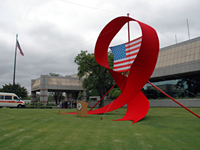
The United States Embassy, the U.S. President’s Emergency Plan for AIDS Relief (PEPFAR), and the Pretoria Diplomatic Association co-sponsored an HIV/AIDS awareness and testing event to demonstrate the power of partnerships and the fight against AIDS. The diplomatic community, government officials, and the press set an example by being tested for HIV/AIDS. A giant red AIDS ribbon hangs in front of the U.S. Embassy in Pretoria to mark World AIDS Day, December 1, 2007. Photo by South Africa PEPFAR team |
|
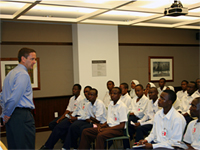
In Tanzania, the Thomas Pickering Information Resource Center worked closely with the PEPFAR team to organize an outreach program to the ‘Stay Alive’ Club from Kinondoni Muslim Secondary School. On December 4, 2007, approximately 40 students watched a screening of the HIV documentary ‘Scenarios from Africa.’ Following the movie, Ambassador Green spoke to the students about leadership. The Ambassador commended them for taking the initiative of coming to the Embassy to view the film and hoped they learned from it. He encouraged the students to learn more about the disease and educate their peers through their club. Ambassador Green also explained how the U.S. Government is working in partnership with the Tanzanian Government to combat HIV/AIDS. Photo by Tanzania PEPFAR team |
|
|



